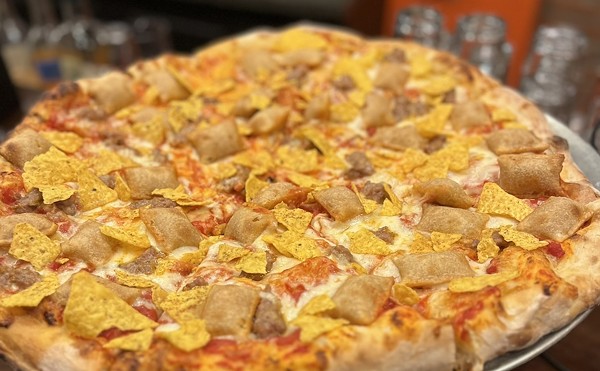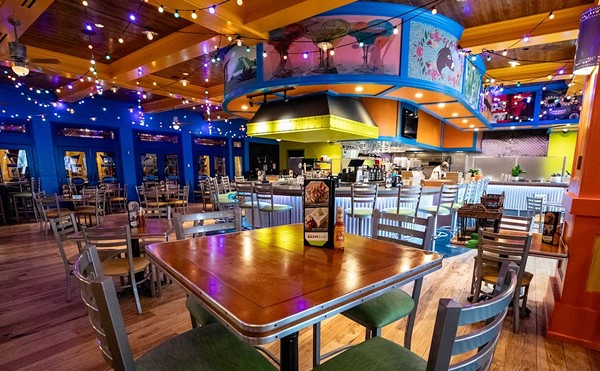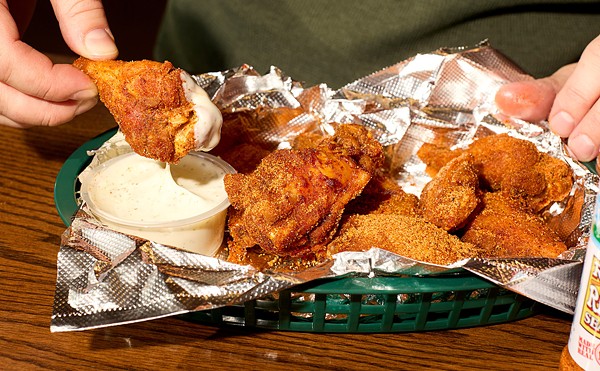I'd been getting better for a very long time. In fact, I hadn't even looked at a Beige Book or even the American Economic Review for years. But the urge was too strong after recent visits to the Route 66 Brewery & Restaurant. I simply had to make assumptions, lay out some equations, analyze the second cross-partials and make my conclusions.
They are: It goes up, and this has immense policy implications.
OK, as is often the case with pronouncements from economists, even recovering ones, the point I'm trying to make may be a bit vague. Let me state it more clearly: Just over two years ago, the owners of what was then called the Old 66 Brewery and Restaurant sank a reported $2.5 million into a former Olive Garden in Crestwood to create a theme restaurant based on the history of Route 66, on which the building actually sat. Moreover, one of the co-owners, Rao Palamand, was a 20-year veteran of Anheuser-Busch, so as part of this massive makeover, the facility included a working microbrewery.
Meanwhile, a similar but unrelated concept -- a working microbrewery, but without a specific theme -- called Bacchus Brewing moved into the old Dierdorf & Hart's space, which offers one of the primo views in all of St. Louis from the arched windows in the front of Union Station, overlooking Aloe Plaza and the Milles Fountain. Oddly enough, Bacchus never did seem to start brewing its own beer, and suddenly it was out and Old 66 was said to be moving in.
But when it did, it mysteriously morphed from "Old 66" to "Route 66" and, equally mysteriously, the Crestwood location closed. That's when the repressed-economist side of my personality emerged. Two-and-a-half mil seemed like an awful lot of overhead to go gently into the night.
On the one hand, this might have looked like a bunch of accounting sleight-of-hand, but on the other hand, there might be a perfectly good explanation. As the great Missourian Harry S. Truman is said to have put it, "Give me a one-handed economist."
Shashi Palamand -- who, along with his father, Rao, is a managing partner of Summit Brewing, which owns Route 66 -- says that just about the same time the company bought out the assets of Bacchus, a California company approached them wanting to buy the Crestwood location and operate their own theme restaurant there. Originally, says Shashi Palamand, the plan was to run the Crestwood and Union Station locations simultaneously, but the offer from the outside company was good enough that they decided to consolidate downtown. Summit Brewing also owns several South End Brewery & Smokehouse restaurants in the Carolinas and Florida.
As for the name, Palamand notes, everyone had been calling the Crestwood location "Route 66" instead of "Old 66" anyway, so after sorting out some trademark issues, they modified the name. And although Union Station isn't exactly right on Route 66, the Palamands managed to find some information indicating that one of the many alignments of the famous "Mother Road" ran down 12th Street, now Tucker Boulevard, just six blocks away.
Mike Wilson remains the chef in the new location, and Palamand says that the menu is basically the same, although it has changed somewhat since we visited the original about two years ago. Back then, we were impressed with the use of stuff like pancetta and langostinos to spruce up basic bar-food offerings such as stuffed potato skins; this time, although we found that some of the items were moderately complex and clever, it appeared that the overall menu has come back toward the center line of what you might expect at a basic meat-and-potatoes spot.
The good stuff included an appetizer of dense, but not heavy, beer-enhanced brown bread, six slices of which were used as the transport device for a rich melt of Asiago cheese, sun-dried tomatoes and wild mushrooms thickened with sour cream and flavored with scallions. It's hard to go wrong with a good melted cheese (as long as it's real cheese and not the oddly popular Provel), and the Asiago had just enough body to balance its moderate salty flavor, with the tomatoes providing bursts of concentrated acid fruitiness.
The crab-stuffed portobellos incorporated a sizeable amount of lump crab, whose flavoring was given just a hint of fire with the addition of bits of poblano chile to similar pieces of red and yellow bell pepper, and both soups we tried -- a French-style onion cut with beer and topped with a slice of Swiss cheese and a dusting of Parmesan, and a delicately herbed creamy wild mushroom -- were well above average.
The entrées we tried were basically big food -- big slabs of meatloaf made even denser by the combination of ground beef with much leaner ground bison, big medallions of pork tenderloin, a big hunk of salmon -- each served with a very big side order of mashed potatoes and a medley of squash, broccoli, cauliflower, snow peas and carrots. The sides, especially, were a throwback to basic roadside-diner food -- basic mashed potatoes and gravy, and vegetables that had spent a little too much time hanging around in the steamer. The gravies and sauces on the entrées were competent but, again, more big and hearty than subtle -- a red-wine, shallot and garlic coating on the meatloaf; sage on the pork and raspberry-jalapeno on the salmon (the sweetness of which brought out a suggestion of fishiness that indicated the salmon might not have been right off that day's truck).
On the other hand (give me a one-handed critic!), the Missouri trout was excellent, its pure flavor serving as a perfect foundation for a subtle lemon-pepper sauce.
I remembered the apple pie from our previous visits, and my memory wasn't disappointed -- still crisp but very thin slices, stacked several layers high, with a smooth caramel sauce at the base. The bread pudding, too, was a fine dessert, rich and thick but not overwhelmingly heavy.
Ten house-brewed beers are listed on the menu, and a seasonal feature rotates, but only six were available on the evening that we visited, and these were predominantly lighter. A Bohemian pilsner was the seasonal specialty, and although refreshing, it was somewhat innocuous, lacking the aromatics of something like a Pilsner Urquell. The darkest of the available choices, the American Brown Ale, was full-bodied without being overpowering and had a smooth, toasty finish. The beers are available in small sampler portions (six at a time) or by the regular glass. Especially in warmer weather, however, I found that the sampler sizes warmed up too quickly and didn't permit sufficient enjoyment of the various bouquets.
The Route 66 theme is captured in any number of ways throughout the restaurant, with one wall decorated with a map outlining the Chicago-to-LA path and reproductions of classic postcards of the '30s and '40s; another featuring the pressed-metal road signs that marked the route; and still another sporting a WPA-style mural of a truck traversing the desert. Although you'll probably intrude on people sitting at their tables, history buffs and Route 66 fans will certainly want to wander around for closeup views of photographs of the various tourist attractions, distinctive hotel and restaurant architectures and other points of interest that marked America's most famous highway.
Although Route 66 offers Sunday hours of operation, be forewarned that you'll find only salads, appetizers and pizza during those hours. The Palamands did this to balance a corporate custom of having at least one day a week off with the tourist reality of Union Station as a seven-day attraction.
Meanwhile, now that I've again recognized that even one or two regression analyses can lead me back on the road to ruin, and that velocity definitely kills, I'm definitely on the bandwagon again and working toward becoming a sober and constructive member of society again -- because, as one of many punch lines to an old joke goes, if you laid all the economists in the world end to end ... it would be a good thing.





